Turning rescued dogs into rescue dogs
At the National Disaster Search Dog Foundation, dogs arent just mans best friendtheyre mans lifeline. Heres a look at what it takes to put a search team together.
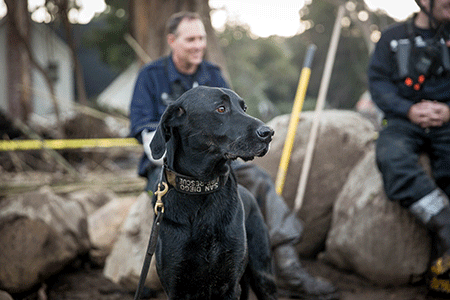
Decker, who was trained at the National Disaster Search Dog Foundation, takes a break while working in Montecito, California. (All images courtesy of the National Disaster Search Dog Foundation.)Just before 4 a.m. on the morning of January 9, 2018, a massive mudslide decimated the beachside community of Montecito, California, sweeping homes and their sleeping inhabitants off their foundations.
Two veteran canine search teams trained by the National Disaster Search Dog Foundation (SDF) had been staged in the area prior to the slide and immediately went to work searching for survivors. As the sun rose that morning, it revealed 30 square miles of devastation, as homes, cars and other debris had washed down from the mountains to the beaches below.
When the magnitude of the disaster became clearer, additional teams from all over California deployed to assist in the rescue efforts. People and dogs worked side by side in the mud during the grueling weeklong mission to find survivors. In total, 18 SDF-trained search teams responded, making it the largest number of SDF teams deployed to a single disaster since Hurricane Katrina in 2005.
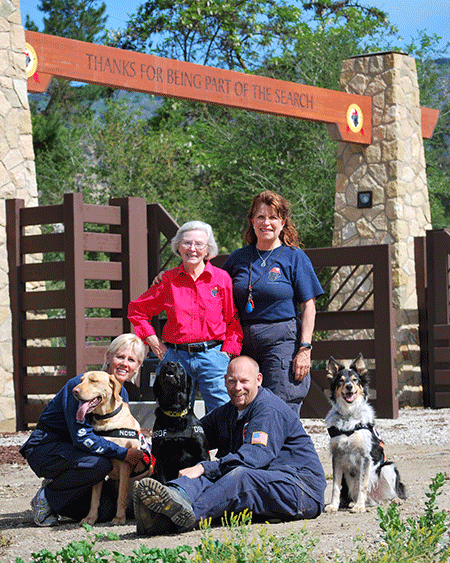
Wilma Melville, in red, founded the SDF in 1995.A start and a place to train
In April of 1995, Wilma Melville, a retired physical education teacher, was deployed with her FEMA-certified search dog Murphy to the site of the Oklahoma City bombing. While there, Melville noticed there weren't enough canine search teams to tackle the needs of the tragedy. Driven and determined to do something about it, she started the SDF that same year.
Based in Santa Paula, California, the nongovernmental organization's mission is to strengthen the United States' disaster response by producing highly skilled canine search teams that can partner with firefighters and other first responders to search for victims of natural disasters and terrorist attacks. It bills itself as the only organization in the U.S. that recruits rescued dogs, gives them ongoing professional training and partners them with firefighters at no cost to their departments.
The SDF National Training Center (NTC) is a state-of-the-art facility occupying 125 acres of donated ranch land that includes specially designed indoor and outdoor kennels for rest and play, training facilities for beginner and advanced dogs, accommodations and classrooms for handlers, and staff offices. Sadly, the massive Thomas Fire in December 2017 burned much of the dog-training facilities, which will need to be rebuilt. Fortunately, the SDF staff was able to evacuate all dogs and personnel before they became trapped by the raging flames.
Caring for a different kind of “rescue” dog
When dogs first come to the NTC from shelters across the country, they're placed under a temporary quarantine to make sure they're healthy and disease-free before entering the organization's dog population. The initial screening includes a physical exam, lab work and, since these are working dogs, orthopedic radiographs to look for signs of conformation issues and degenerative joint disease.
Why use dogs in search-and-rescue operations?
The SDF recognizes that no piece of technology or person can match a dog's speed and accuracy in finding people trapped in disaster wreckage. This is thanks to a canine's:
remarkable sense of smell and ability to ignore other scents and noises-even tempting traces of food or other animals or people involved in the search
unparalleled ability to quickly and safely navigate unstable and slippery terrain
capacity to negotiate dangerous surfaces while keeping focused on the job at hand
ability to work off-leash and get to places humans can't safely access
insatiable drive to hunt and search.
Veterinary care at the SDF is provided by Ohana Pet Hospital in Ventura, California. Every two weeks, either Jill Muraoka Lim, DVM, or Katherine Byrne, DVM, two of Ohana's founding partners, along with a few technical staff members, make a “house call” at the NTC to perform physical exams, administer vaccines and provide basic veterinary care for the gamut of illnesses and injuries that can occur.
“We diagnose and treat a variety of orthopedic injuries (mainly joint issues), neuropathies, other soft-tissue injuries, foot injuries and skin issues directly related to the vigorous training the dogs undergo,” says Dr. Lim.
Because it's important for the handlers to know how to identify when their dogs require emergency care (as in cases of bloat, heatstroke or dehydration), as well as how to provide first aid in the field, the Ohana veterinarians are also helping the SDF refine its medical training protocols for their firefighter handlers. They've been able to teach the handlers basic first aid, wound care and bandaging.
“We all enjoy the work we do with the SDF dogs and their dedicated staff,” says Dr. Lim. “Working with local nonprofit groups like the SDF is an honor and a way for us to give back to our community.”
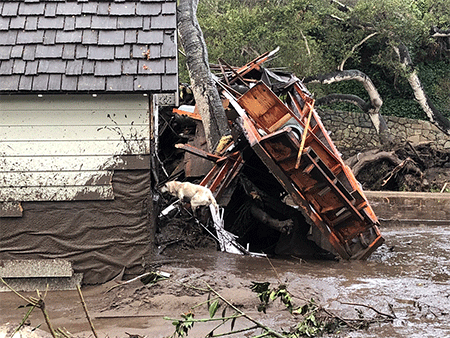
SDF dog Riley at work after the mudslides in Montecito, California.Some dogs have it. Some don't
A disaster site is a treacherous environment. It can be noisy, chaotic, dust-filled and dark. Over the 22 years since its founding, the SDF has honed a carefully crafted set of evaluations to identify promising canine candidates.
“It takes an extraordinary dog-with extreme boldness, intense drive, energy, strength, athleticism, agility and focus-to approach every training exercise and deployment with energy and determination,” says Denise Sanders, director of communications for the SDF. “These are dogs that love to work, need to work, and want nothing more than to be out on the rubble searching.”
The breeds most likely to have these qualities, according to the SDF, are Labradors, golden retrievers, border collies, German shepherds, Belgian Malinois and mixes of these breeds.
“These specific breeds are ‘air-scenting' dogs that sniff with their noses up in the air,” says Sanders. “When they scent a victim, you can see them whip their heads around to get into the ‘scent cone,' which is a cone-shaped area that goes out from a pinpointed spot and widens over the rubble. You can see the dog hit upon the scent and zero in on the cone. It'll wheel around and zigzag on it until it gets to the strongest scent spot.”
This is the point at which the dog's nose goes down and it alerts the handler. The rescue crew (which may be up to 75 people, plus equipment and machinery) can then get to work at that site.
“The dog's ability is really phenomenal. It's built for it,” says Sanders.
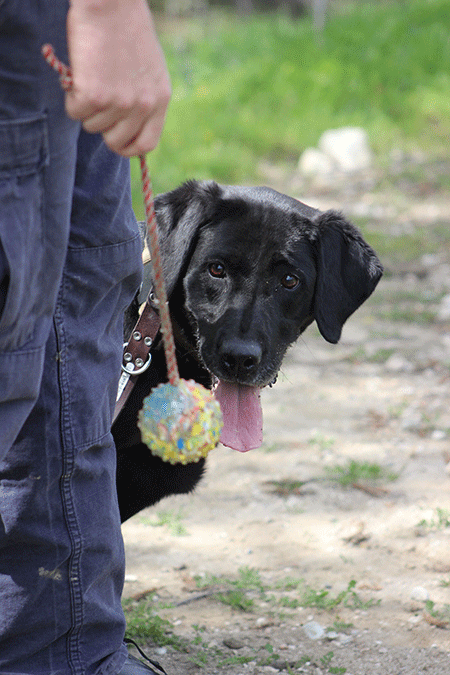
Stella's toy obsession is one of the qualities that made her the right recruit for the SDF.The process: From rescued dog to search-and-rescue dog
What does it take to successfully transform a shelter dog into a highly trained search-and-rescue team member? Some innate abilities and characteristics and a lot of hard work. The process has five stages:
1. The right rescue recruits. Because the SDF uses shelter dogs, timing is of the essence, as the best kind of dog for the job can end up on the “unadoptable” list for having an insatiable work ethic. It may even end up euthanized, which is an especially sobering thought considering that lost life could've saved a life one day.
“With their level of excessive energy and toy obsession, some of these dogs would not make great pets,” says Sanders. “They're more likely to chew up a couch than be a couch potato.”
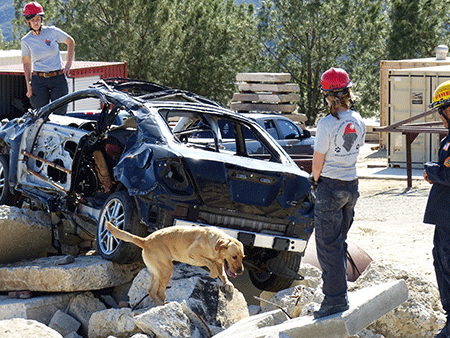
SDF dog Clancy trains on a rubble pile at the NTC.2. Reward-based training. Evaluation, socialization and training at the NTC takes about eight to 12 months per dog, but every dog has its own canine learning curve. Some dogs fly through the training period, while others need more time. A dog might proceed without problems on certain aspects of the training process and then plateau, needing a little more time or attention to learn certain skills.
First things first, assessing a dog's innate energy and endurance is critically important, as these qualities will need to carry the dog through its career for the next eight to 10 years.
“We're looking for laser-like focus and a huge toy-seeking drive (or a drive to hunt and search in general),” says Sanders. “The dogs at the NTC come to know that their toy is their reward, and they're the kind of dogs that will play fetch until they collapse. These dogs will not quit unless you make them, and that's exactly what we're looking for. We look for those qualities at the outset and continue to enhance them during the training period.”
2017 SDF team deployments
Puerto Rico: Hurricane Maria
Mexico City: earthquake
Florida: Hurricane Irma
Gulf Coast: Hurricane Harvey
West Dallas, Texas: missing persons
Utica, New York: building collapse
Orange County, California: vehicle crash
Eagle Mountain, Utah: missing person
Canton, Texas: tornado
Irvine, California: missing person
Bethlehem, New York: missing person
Dallas, Texas: tornado pre-staging
Hollywood Hills, California: mudslide
Trabuco Canyon, California: flood
Los Angeles County, California: flood pre-staging
In fact, the first thing a dog learns at the NTC is that it can bark to get the toy it loves.
“The dog tends to have a lightbulb moment in which it realizes that not only can it bark for a toy, it's encouraged to bark for a toy-and is rewarded when it does,” says Sanders. “The dog learns that it can use what was formerly considered bad behavior to its advantage.”
As soon as this concept “clicks,” the canine trainee starts picking up on the rest of its training, like locating people hidden in barrels.
“We line up about eight to 10 barrels together, and only one contains a person. Once the dog barks at the barrel containing the person, the toy comes out as a reward,” says Sanders.
As the dog progresses, the trainers make the challenges increasingly complicated. For example, the barrels are next spread apart so the dog has a greater area to cover, and then the barrels are placed haphazardly throughout the training area.
“Each step of the way, the dog is rewarded and told that it's a fantastic dog-that it's doing great work,” says Sanders. “The dog is learning and building its confidence at the same time.”
The goal is to eventually get the dog on a rubble pile that's similar to an actual disaster situation. Volunteer “victims” hide in the rubble, and the dog is tasked with finding them to earn a toy. This simulation equips the dog to find people who would otherwise remain buried after a disaster.
“Rubble pile footing is the last concept we train the dog to do, but it's also what we test for initially when the dog first comes through our gate,” says Sanders. “If the dog isn't willing to go up on a rubble pile-especially one with precarious, uneven footing, or even footing that's moving-for a toy reward, it won't make it. If the dog's drive isn't enough, it's not going to work out during the training. We don't ever want to force a dog to do something it's not comfortable with.”
Obedience work is also part of the training at the NTC, as the dog has to learn to mind its handler. Whether the dog is at home, at the fire station or at a disaster site, it has to mind its manners.
3. Handling handler recruitment. Picking the right handler can be just as important as picking the right dog.
“These dedicated men and women have to love the process and the training to be ready to deploy when disaster strikes,” says Sanders. “The SDF doesn't just interview the firefighters, but also their spouses or significant others. We want to ensure that both fully understand the commitment and have a full support network in place.”
The firefighter handlers volunteer their off time to search-and-rescue training, with a small stipend from FEMA or the state for disaster deployment.
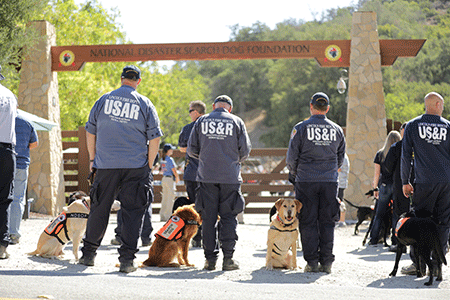
SDF dogs with their firefighter handlers. 4. Handler-dog team training. A dog is trained for eight to 12 months before it ever meets its handler, and then the SDF works closely with the handler-dog team for 14 days to make sure it's a good fit. Often, says Sanders, the handler needs to catch up to the skill level of the dog-a process that can't be rushed.
“We can't push. We have to give them whatever time it takes to jell, dog to handler and handler to dog,” says Sanders.
During this time, the handler is evaluated on skill level, personality and mannerisms, all of which are important aspects of the team.
At the end of the two-week course, the SDF's training team passes the leash from trainer to handler. Then, the firefighter takes the dog home, continuing to train under the SDF team's supervision.
5. FEMA/state certification training. After graduating from the SDF, the handler-dog team goes through an additional year of training to achieve type 1 certification through either FEMA or the state. The process consists of a foundation skills assessment that tests the dog's agility, obedience and basic search skills.
The dog needs to be able to negotiate two 10,000-square-foot piles of rubble, wood and debris, locating victims within a certain timeframe determined by FEMA and the state. Success in these tests is that no victim is left behind, which at the end of a given disaster day is the dog's “job.”
2018 SDF team deployments
Waterford, New York: missing person
Irving, Texas: parking garage collapse
Glendale, Utah: missing person
Poughkeepsie, New York: building collapse
Santa Barbara, California: mudslide pre-staging
Miami, Florida: bridge collapse
Malone, New York: flood pre-staging
Delaware County, Pennsylvania: missing person search
Montecito, California: mudslides
One of the rubble piles is considered a full-access pile, which means the handler can walk anywhere. The other is a limited-access pile, where the handler must demonstrate that he or she can control the dog via hand or verbal commands. Here's how it works: The handler sends the dog out to search, and once the dog finds the victim and alerts the handler, the handler goes to where the victim is and resends the dog to cover the rest of the pile. This leapfrog-like exercise reveals whether or not the dog can work without the handler by its side. During deployment, the dog will have to work independently.
As the year proceeds, the bond between handler and dog grows to form a workable partnership. Once certified, this highly trained team can be deployed to disasters anywhere in the nation.
To date, the SDF has trained more than 200 teams that have deployed to 172 disasters and missing person searches. There are currently 70 SDF-trained search teams located in California, Florida, Nebraska, New York, Oklahoma, Pennsylvania, Texas, Utah, Virginia and Baja California. Still, there's a shortage of canine disaster search teams in the U.S., as it's estimated that 450 teams are needed to adequately respond to disasters-about twice the number currently in active service. To learn more about how you can partner with the SDF's mission, visit searchdogfoundation.org.
Ed Kane, PhD, is a researcher and consultant in animal nutrition. He is an author and editor on nutrition, physiology and veterinary medicine with a background in horses, pets and livestock. Kane is based in Seattle.
FDA approves oral drug for broad canine protection against parasites
October 7th 2024Elanco's lotilaner, moxidectin, praziquantel, and pyrantel chewable tablets (Credelio Quattro) provide a single monthly dose for protection against fleas, ticks, heartworms, roundworms, hookworms, and 3 species of tapeworm.
Read More
dvm360 announces winners of the Veterinary Heroes program
Published: September 6th 2024 | Updated: November 5th 2024This year’s event is supported by corporate sponsor Schwarzman Animal Medical Center and category sponsors Blue Buffalo Natural, MedVet, Banfield Pet Hospital, Thrive Pet Healthcare and PRN Pharmacal.
Read More